Frogs are on the edge. Blasted by habitat loss, pollution, and a terrible disease, the chytrid fungus, species are vanishing worldwide and those that remain are clinging to existence, rather than thriving. However, an interview with Pierre Fidenci, President of Endangered Species International (ESI), proves that there are still areas of the world where amphibians remain in abundance.
South Korea is not a country that is talked about frequently in conservation circles. Other nations in the region attract far more attention, such as Malaysia and Indonesia. But it was just this neglect that drove Pierre Fidenci to visit the nation and survey the amphibians there.
“We have little information about the amphibians of Korea,” Fidenci explains, “but, most importantly, I was very keen to look at a country that is covered by 65 percent forest, including numerous rice paddies, which are used by many frogs and salamanders. Many of my surveys and conservation work has occurred in places in the world where deforestation is rampant and forest coverage is less than 10 percent, especially in the tropics.”
 Pierre Fidenci. |
Fidenci was able to observe many of South Korea’s 18 amphibian species in the wild and what he found was generally positive. South Korea’s large percentage of forest cover “provides essential natural habitat for amphibians in general,” while there are still “a good number of rice fields and creeks that also support amphibians, like the Amur Brown frog, for breeding and foraging.”
But what about the chytrid fungus, which has devastated so many amphibian populations?
“Korean scientists have already found the chytrid fungus and populations of the introduced bullfrog, carrier of the chytrid fungus, occur in South Korea. However, at the present time, there is no evidence at all that the chytrid fungus is impacting amphibians in Korea,” Fidenci said, adding that “bullfrogs are localized in few areas and have difficulties expanding their range probably due to the lack of adequate habitat and corridors, and a past campaign to eradicate them.”
Part of the success of amphibians in South Korea, Fidenci believes, is due to the way the country has grown—upward rather than outward.
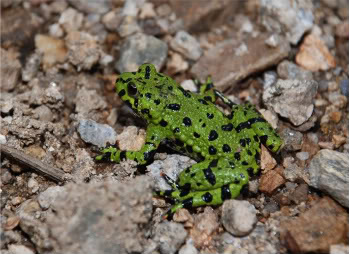 Oriental fire-bellied toad Bombina orientalis observed along a creek. Photo by: Pierre Fidenci. |
“Urbanization does not occur the same way as in the United States and Europe where we build houses to live in which I call the ‘horizontal process’, whereas in South Korea we see a ‘vertical urbanization process’ by building very high apartment buildings and no houses!” This has left far more intact natural habitat available for amphibians and other species.
One concern that remains for Fidenci is the affect of air and water pollution on South Korea’s frogs. Although he saw little direct evidence, he says that “new research is needed”.
Fidenci’s trip to South Korea was very much in character, since as President of ESI he has steered his organization to work with little-known species that other conservation organizations have overlooked. He says such conservation efforts are difficult due to a lack of awareness, data, and financial support.
“As you know people like to support emblematic species like the panda or the mountain gorilla. But at ESI we need to keep working on ‘forgotten’ species, we cannot have our decisions dedicated by conventional public interests but by science and urgency,” he explains.
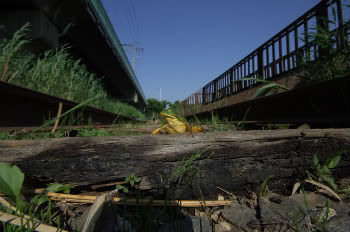 The endangered gold spotted pond frog Rana plancyi chosemica found in urbanized area. Photo by: Pierre Fidenci. |
In addition to working with these little known species he has gathered rare footage of some truly wonderful subjects (videos at the end of the article), including the Philippine’s ‘white squirrel’ whose taxonomy is still being studied, and the tarsier.
Mongabay.com spoke with Pierre Fidenci about his recent trip to South Korea and his work as President of ESI.
Mongabay: What is your background? How did you become interested in amphibians?
Pierre Fidenci: I was born and raised in southern France. I conducted my undergraduate and graduate studies in France and the United States. Since a very young age I was fascinated by amphibians and reptiles. At the age of 12, I spent quite some time between school breaks observing frogs, snakes, and turtles. At the age of 18, I created a small organization to promote conservation of amphibians and reptiles in France. My interest for amphibians emerged quickly from my passion for nature.
SOUTH KOREAN AMPHIBIANS
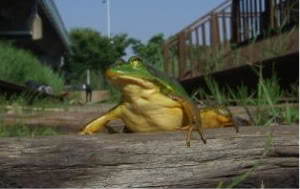 Close up of the gold spotted pond frog Rana plancyi chosemica. Photo by: Pierre Fidenci. |
Mongabay: You recently traveled to South Korea to assess the state of amphibians in the country. Why did you choose South Korea?
Pierre Fidenci: Well, several reasons! First as a westerner we have little information about the amphibians of Korea, but, most importantly, I was very keen to look at a country that is covered by 65 percent forest, including numerous rice paddies, which are used by many frogs and salamanders. Many of my surveys and conservation work has occurred in places in the world where deforestation is rampant and forest coverage is less than 10 percent, especially in the tropics. The choice of South Korea was made due to a mix of great curiosity, particular environmental conditions, and lack of information available on the country’s amphibians.
Mongabay: What are some notable amphibian species in South Korea?
Pierre Fidenci: There are 13 frog and five salamander species. Many species (eleven of them) live in mountainous areas which include all salamanders. The rest mostly breed in agricultural areas amongst rice paddies and small streams. As far as notable amphibians, I’d like to cite the oriental fire-bellied toad (Bombina orientalis), a very common species that fascinates me; the Suweom treefrog (Hyla suweonensis), endangered and endemic to Korea; the endangered boreal digging frog (Kaloula borealis) which spends most of its time underground not too far from rice fields; the Amur Brown Frog (Rana coreana) endemic to Korea; the endangered gold spotted pond frog (Rana plancyi chosemica) surviving in localized areas sometimes very urbanized; and finally the only Asian and endemic plethodontid, the Korean crevice salamander (Plethodonid Karsenia koreana).
Mongabay: What are your general findings from your survey?
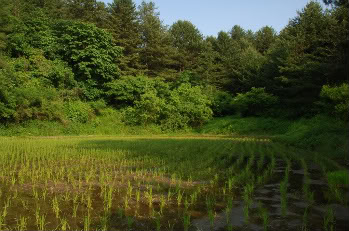 Habitat for six of South Korea’s amphibian species. Photo by: Pierre Fidenci. |
Pierre Fidenci: Well, first we were very happy to observe most of the amphibians in the field thanks to the great information shared by Park Daesik, a Korean herpetologist. Two species of amphibians are classified as endangered: the boreal digging frog and the gold spotted pond frog, both threatened by habitat destruction and degradation. Overall, compared to other countries, South Korea has a very good natural coverage of forest (65 percent) and therefore provides essential natural habitat for amphibians in general. In addition, even though many rice paddies are being replaced by urban developments, we still have a good number of rice fields and creeks that also support amphibians, like the Amur Brown frog, for breeding and foraging. Since habitat destruction and degradation are one of the main threats to amphibian worldwide, in this regard, overall South Korean’s amphibians are in a good shape.
Mongabay: Has the chytrid fungus hit South Korea’s frog species yet?
Pierre Fidenci: Korean scientists have already found the chytrid fungus and populations of the introduced bullfrog, carrier of the chytrid fungus, occur in South Korea. However, at the present time, there is no evidence at all that the chytrid fungus is impacting amphibians in Korea. Further, fortunately bullfrogs are localized in few areas and have difficulties expanding their range probably due to the lack of adequate habitat and corridors, and a past campaign to eradicate them.
Mongabay: Why do you think South Korea’s amphibians are doing well, whereas around the world amphibians are declining drastically with many species going extinct?
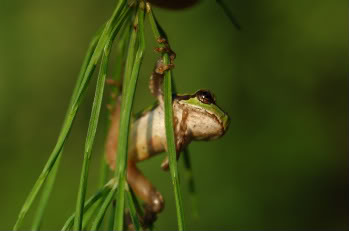 Hyla japonica: The Japanese tree frog was used for traditional medicine in South Korea. Photo by: Pierre Fidenci. |
Pierre Fidenci: In general, South Korea’s amphibians appear to be doing well because of the persistence of wide suitable natural habitat. Urbanization does not occur the same way as in the United States and Europe where we build houses to live in which I call the “horizontal process”, whereas in South Korea we see a “vertical urbanization process” by building very high apartment buildings and no houses! If you would just take 50 percent of those people living in apartment buildings and build them houses with gardens, you will see a tremendous loss of natural habitat.
As far as the impact of air pollution on South Korea’s amphibian, it is unknown. New research is needed to assess the anthropogenic impacts via air and water pollution on amphibians like the use of herbicides in rice fields. Laboratory studies have shown the negative effects of agricultural chemicals like endosulfan, but we do not know how it is translating in the field. We did observed a lot of amphibians successfully breeding in some rice fields using herbicides.
Mongabay: Do you believe climate change is having an impact on amphibians in South Korea?
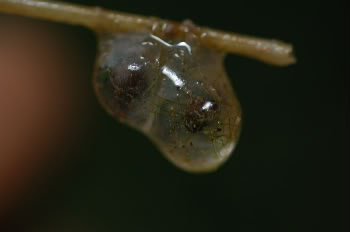 Oriental fire-bellied toad (Bombina orientalis)egg mass. Photo by: Pierre Fidenci. |
Pierre Fidenci: That’s a good question. Scientifically, I cannot say that climate change is impacting South Korean amphibians, we don’t have evidence as such. We are lacking considerable amount of data and as I said earlier most of amphibian species are still doing well in South Korea! I believe that we may start to observe an impact in the near future. For now, the current biggest impact is habitat loss and probably air pollution from Seoul and China, but we have not evidence on that either.
Mongabay: How do locals in South Korea view frogs and other amphibians? Are any of these species subject to hunting for food or medicine?
Pierre Fidenci: In general, Korean have a good view of amphibians including toads. Amphibians have long been used for food and traditional medicine in rural areas. Some species like the Japanese tree frog and the gold spotted pond frog were used for asthmatic conditions, fewer, and infectious diseases.
Mongabay: East Asia is in the midst of a biodiversity crisis with such problems as high levels of deforestation, bushmeat and poaching for medicine, growing human population, and climate change. How do you think South Korea is faring with biodiversity—not just amphibian—compared to neighboring nations?
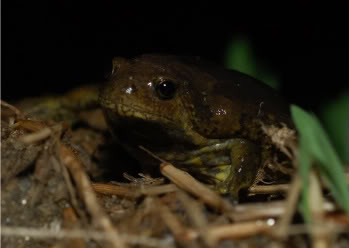 The endangered boreal digging frog observed at night. Photo by: Pierre Fidenci. |
Pierre Fidenci: South Korea is a rich country so they do not face the problems as their neighbors besides of course climate change.
ENDANGERED SPECIES INTERNATIONAL
Mongabay: You are currently founder and president of Endangered Species International (ESI). How did you decide to start the organization?
Pierre Fidenci: I was not satisfied with what I experienced as a volunteer for other organizations. I wanted ESI to differ from other organizations and make sure that we have a significant positive impacts on biodiversity. In the past, I witnessed waste of funds and resources, lack of transparence and honesty, difficulties to adapt with local communities, and more, and all that troubled me. The core value of ESI is to tackle the problem at its root (if we can identify it) and conduct conservation work with local people.
Mongabay: What are the goals of your organization? How do you see ESI as being different from other conservation organizations?
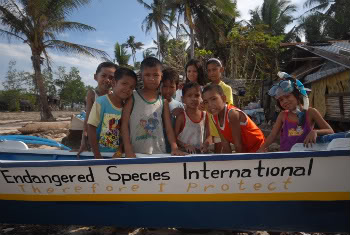 ESI conservation awareness in small villages in Southeast Asia. Photo by: Pierre Fidenci. |
Pierre Fidenci: The main goal is to reverse the trend of human-induced species extinction by saving endangered animals and preserving their wild places. Basically, we focus on preserving biodiversity. ESI is different from other organizations because of the way we operate, we look for and implement unconventional solutions to protect biodiversity, and we must know the ground and the people better than anybody else. If you take some large groups, they are governed by people who lose sense of the ground reality, leading to failure or poor results. In the case of ESI, for example, I know all our activities on the ground no matter where we are in the world and from the birth of the project!
Mongabay: Can you tell us about the ‘white squirrel’ and the Balabac mouse deer, both of which are endemic to the Philippines?
Pierre Fidenci: The white squirrel is found on a small island in the Philippines. We are waiting for taxonomic results to see if it is a different species or subspecies from the main island. They are not albinos and most of them are white. The Balabac mouse deer is the world’s smallest deer and occurs on small islands between Palawan (Philippines) and Borneo (Malaysia). This deer is threatened by increasing hunting activities and deforestation. The good news is that indigenous leaders and local communities are fully supporting our project and ESI was the first conservation organization accredited in the area!
Mongabay: Is it difficult to receive support when you are working with species that few people have heard of, but are truly at the edge of extinction?
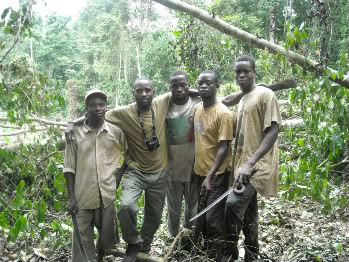 ESI African team in Congo lead by Franck Makoundi. Photo by: Pierre Fidenci. |
Pierre Fidenci: Very difficult indeed! As you know people like to support emblematic species like the panda or the mountain gorilla. But at ESI we need to keep working on “forgotten” species, we cannot have our decisions dedicated by conventional public interests but by science and urgency.
Mongabay: What have been some of the greatest successes of ESI?
Pierre Fidenci: Your question is important because we need to hear success stories that will encourage us to move forward. We have successes, but let’s be honest, they are hard to obtain and most of the time a project will become a success after decades of hard work, not in one month or year! Some of the important ESI achievements are changing behavior in kids we have worked with, replacing illegal hunting by sustainable alternatives, providing knowledge and leaderships to young conservationists in the tropics, creating reserves, and protecting endangered animals.
Mongabay: You have some great footage or rare and unusual animals on YouTube. How do you capture it?
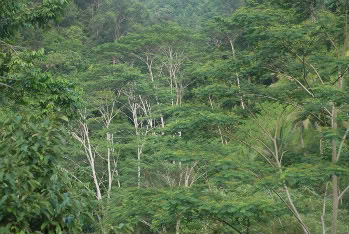 ESI rainforest conservation site in Southeast Asia. Photo by: Pierre Fidenci. |
Pierre Fidenci: It is not easy! First, you need to know the ecology very well of your animal that you are targeting. You need a lot patience and some luck too to get a good footage! Finally, most of the time you need to have a local who will guide you throughout the jungle or the ocean! It is always a great satisfaction to get a good footage that can be used to promote conservation and change the way people see the world.
Mongabay: Do you think the global extinction crisis is worsening or improving?
Pierre Fidenci: The global extinction crisis is worsening, there is no doubt about that! We keep losing species every day and many more are going to the brink of extinction. But let’s not forget that there are great success stories too, well, not enough of them I concede, but we can reverse the tide and save ourselves and the biodiversity around us!
Mongabay: With so many species requiring conservation efforts, how do you decide where to put your focus?
Pierre Fidenci: We put our focus depending on the degree of urgency (not all endangered species have the same degree of extinction, some are much more threatened), our experience and expertise, and the location (we tend to go to places where no other conservation NGOs work). We focus on endangered species found in various types of habitat and serving as protecting umbrella to other endangered species and various wild habitat. Please join ESI!
Discovering the Tarsier. Video by ESI.
Undescribed ‘white squirrel’ in the Philippines. Video by ESI.
Amphibians of Palawan. Video by ESI.
Related articles
Save the frogs, save ourselves

(09/04/2009) Amphibians are going extinct around the globe. As a scientist specializing in frogs, I have watched dozens of species of these creatures die out. The extinction of frogs and salamanders might seem unimportant, but the reality couldn’t be farther from the truth. Indeed, from regulating their local ecosystems, to consuming and controlling the population of mosquitoes and other insects that spread disease, to potentially pointing the way to new drugs for fighting diseases such as cancer or HIV-AIDS, the fate of these creatures is inexorably linked to our own.
The story of ‘Save the Frogs Day’, April 28th, An Interview with Kerry Kriger
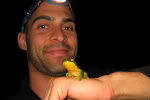
(04/26/2009) Founder and director of SAVE THE FROGS!, Dr. Kerry Kriger is responsible for the first annual Save The Frogs Day on Tuesday, April 28th with events planned worldwide from the United States to Nepal, and Australia to China. “I’m continually amazed at the positive response it’s gotten. I thought of Save The Frogs Day one night last December when I was the only full-time SAVE THE FROGS! employee and I only had a couple part-time volunteers,” Kriger explains.
After disease engulfs island, rare mountain chicken frogs airlifted to safety
(04/23/2009) In a rescue operation that sounds straight out of an action film, 50 mountain chicken frogs were airlifted from the Caribbean island Montserrat after the discovery of Chytridomycosis, a fungal disease that has wiped out amphibian populations worldwide. Already, hundreds of the critically-endangered mountain chicken frogs succumbed to the disease, which is thought to have made its way to the island in late 2008 or early 2009.